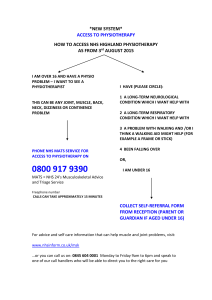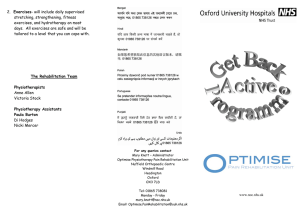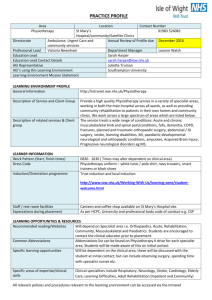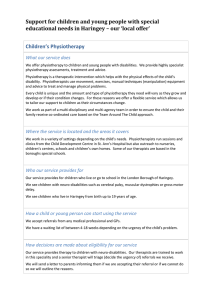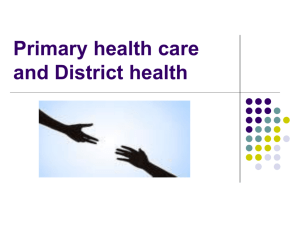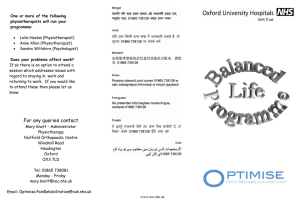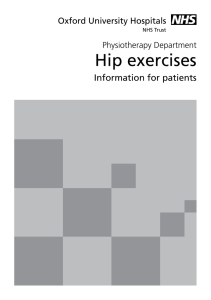Developing the SELF study: A focus Research and learning methodologies
advertisement
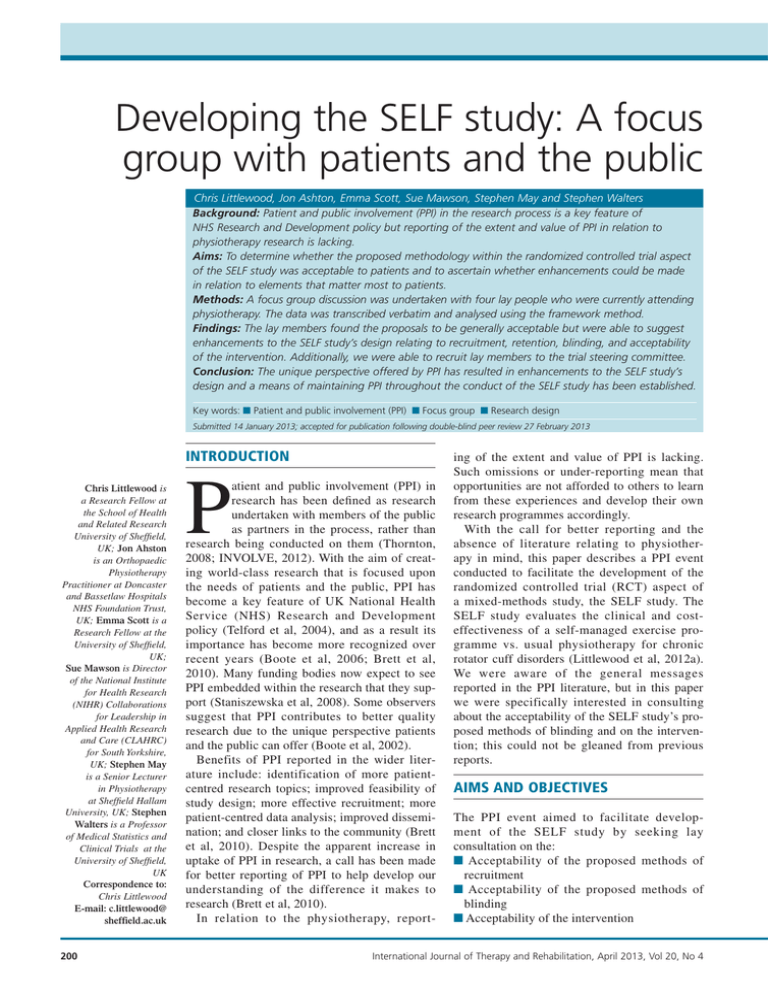
Research and learning methodologies Developing the SELF study: A focus group with patients and the public Chris Littlewood, Jon Ashton, Emma Scott, Sue Mawson, Stephen May and Stephen Walters Background: Patient and public involvement (PPI) in the research process is a key feature of NHS Research and Development policy but reporting of the extent and value of PPI in relation to physiotherapy research is lacking. Aims: To determine whether the proposed methodology within the randomized controlled trial aspect of the SELF study was acceptable to patients and to ascertain whether enhancements could be made in relation to elements that matter most to patients. Methods: A focus group discussion was undertaken with four lay people who were currently attending physiotherapy. The data was transcribed verbatim and analysed using the framework method. Findings: The lay members found the proposals to be generally acceptable but were able to suggest enhancements to the SELF study’s design relating to recruitment, retention, blinding, and acceptability of the intervention. Additionally, we were able to recruit lay members to the trial steering committee. Conclusion: The unique perspective offered by PPI has resulted in enhancements to the SELF study’s design and a means of maintaining PPI throughout the conduct of the SELF study has been established. Key words: n Patient and public involvement (PPI) n Focus group n Research design Submitted 14 January 2013; accepted for publication following double-blind peer review 27 February 2013 INTRODUCTION Chris Littlewood is a Research Fellow at the School of Health and Related Research University of Sheffield, UK; Jon Ahston is an Orthopaedic Physiotherapy Practitioner at Doncaster and Bassetlaw Hospitals NHS Foundation Trust, UK; Emma Scott is a Research Fellow at the University of Sheffield, UK; Sue Mawson is Director of the National Institute for Health Research (NIHR) Collaborations for Leadership in Applied Health Research and Care (CLAHRC) for South Yorkshire, UK; Stephen May is a Senior Lecturer in Physiotherapy at Sheffield Hallam University, UK; Stephen Walters is a Professor of Medical Statistics and Clinical Trials at the University of Sheffield, UK Correspondence to: Chris Littlewood E-mail: c.littlewood@ sheffield.ac.uk 200 P atient and public involvement (PPI) in research has been defined as research undertaken with members of the public as partners in the process, rather than research being conducted on them (Thornton, 2008; INVOLVE, 2012). With the aim of creating world-class research that is focused upon the needs of patients and the public, PPI has become a key feature of UK National Health Service (NHS) Research and Development policy (Telford et al, 2004), and as a result its importance has become more recognized over recent years (Boote et al, 2006; Brett et al, 2010). Many funding bodies now expect to see PPI embedded within the research that they support (Staniszewska et al, 2008). Some observers suggest that PPI contributes to better quality research due to the unique perspective patients and the public can offer (Boote et al, 2002). Benefits of PPI reported in the wider literature include: identification of more patientcentred research topics; improved feasibility of study design; more effective recruitment; more patient-centred data analysis; improved dissemination; and closer links to the community (Brett et al, 2010). Despite the apparent increase in uptake of PPI in research, a call has been made for better reporting of PPI to help develop our understanding of the difference it makes to research (Brett et al, 2010). In relation to the physiotherapy, report- ing of the extent and value of PPI is lacking. Such omissions or under-reporting mean that opportunities are not afforded to others to learn from these experiences and develop their own research programmes accordingly. With the call for better reporting and the absence of literature relating to physiotherapy in mind, this paper describes a PPI event conducted to facilitate the development of the randomized controlled trial (RCT) aspect of a mixed-methods study, the SELF study. The SELF study evaluates the clinical and costeffectiveness of a self-managed exercise programme vs. usual physiotherapy for chronic rotator cuff disorders (Littlewood et al, 2012a). We were aware of the general messages reported in the PPI literature, but in this paper we were specifically interested in consulting about the acceptability of the SELF study’s proposed methods of blinding and on the intervention; this could not be gleaned from previous reports. AIMS AND OBJECTIVES The PPI event aimed to facilitate development of the SELF study by seeking lay consultation on the: n Acceptability of the proposed methods of recruitment n Acceptability of the proposed methods of blinding n Acceptability of the intervention International Journal of Therapy and Rehabilitation, April 2013, Vol 20, No 4 n Measures to minimize loss to follow-up. These objectives were set to reflect issues that are widely regarded as being problematic when conducting RCTs generally (Torgerson and Torgerson, 2008), but in relation to blinding and acceptability of the intervention these objectives were set to reflect specific issues relating to the SELF study. To maintain ongoing PPI an additional objective was to recruit lay people to the SELF study trial steering committee with the remit of monitoring the progress of that study. This final objective reflects a move from consultative PPI where the control remains with the academic researchers, to a more equal partnership where decision-making is shared (Brett et al, 2010). METHODS In accordance with the National Research Ethics Service (NRES) guidance, ethical approval was not required for this involvement event. While the protocol for the SELF study was under development, we undertook the focus group discussion. Posters advertized the focus group to potential lay members in the physiotherapy department of the host NHS institution where the SELF study was due to be conducted. The poster simply asked for volunteers who would be willing to contribute to a discussion about our proposed research. We invited adults (>18 years old) under the care of physiotherapy services to contact Chris Littlewood (CL) or John Ashton (JA) in person, via the telephone or by e-mail, to indicate their interest, and to discuss their potential role and extent of their involvement. We used a convenience sampling approach for pragmatic reasons relating to recruitment and time available prior to the SELF study’s RCT protocol submission for ethical approval. Most of the objectives of this study, with the possible exception of gauging the intervention’s acceptability, might be regarded as generic and therefore relevant to any willing service user. However, it is unclear whether purposive sampling of potentially-eligible SELF study participants would have offered any further or contradictory information to that offered by patients currently attending physiotherapy for non-shoulder related disorders. The focus group When members consented to be involved they were invited to attend the focus group discussion led by CL and JA within the physiotherapy department of the host institution. To express gratitude for their involvement the participants received a £25 voucher and reimbursement of travel expenses. The focus group commenced with introductions and all members were aware that CL and JA were researchers and physiotherapists by background. A structured topic guide was developed, with reference to the study’s objectives, to facilitate discussion which was recorded and transcribed verbatim by CL. Member responses were anonymised. We analysed the data using the framework approach, which incorporates the following stages: n Familiarization—where key ideas and themes are identified n Identification of a thematic framework by which the data can be examined n Indexing—application of the thematic framework to all the data n Charting—where the data is organized according to the defined thematic framework n Mapping and interpretation—where the charts are used to define concepts and find associations with a view to providing explanations for the findings (Pope et al, 2000). This approach is widely recognized as appropriate for applied research in which the objectives are set a priori (Pope et al, 2000). CL undertook the analysis and then JA reviewed and verified this analysis. Subsequently, we produced a lay summary detailing key messages from the discussion and how the proposed research was to be developed as a result. The participants were sent a copy of this summary and invited to respond. Three out of the four members responded and approved the proposed changes. One member did not respond for unknown reasons, despite prompting. RESULTS Four patient members contributed to the focus group. Six initially volunteered but two, without explanation, did not attend on the day. All patients were female (age range 19–80 years) and currently attending physiotherapy for a range of musculoskeletal disorders, including past and present shoulder disorders. The discussion began with the members briefly describing their previous involvement with research. Two of the four had previously participated in research: one as a patient and one as the partner of a patient. They were asked to consider if they would volunteer for future research and the factors that might motivate them to do so. All of the members described International Journal of Therapy and Rehabilitation, April 2013, Vol 20, No 4 201 Research and learning methodologies personal benefit as a factor but also considered the benefits to the NHS and the wider population. This point was recognized by Member A: ‘...anything that’s gonna help me and other people is important...’ Acceptability of the proposed methods of recruitment We proposed to make initial contact with potential SELF study participants by telephone. Upon receipt of the referral to the physiotherapy department, the information would be screened by a physiotherapist and then the call would be made to those who were potentially eligible. Although the members felt that this was appropriate, they suggested that it might not be the most effective way. The idea of a letter informing the potential participants of the study and the intention to contact them prior to a telephone call was suggested. Member A reflected: ‘If you just get a random call then it’s not very good for you. You might be out doing something and if you’re busy or whatever and you’re not expecting the call then you might just brush it off and not want anything to do with it, so I think the letter’s a good idea.’ Following initial contact the participants would need to undergo a physical examination screening prior to recruitment. This means some of the invited participants would be subsequently excluded, and we were concerned that this might negatively impact upon willingness to volunteer. However, Member B, agreed with the others: ‘No, it wouldn’t because (the research physiotherapist) would have decided who were going to be the best people to do this. You would be allocated a physiotherapist anyway wouldn’t you, so no.’ Acceptability of the proposed methods of blinding The SELF study was designed to evaluate the clinical and cost effectiveness of a self-managed exercise programme vs. usual physiotherapy. A survey of current UK physiotherapy practice (Littlewood et al, 2012b) relating to rotator cuff disorders has identified that usual physiotherapy might include a range of interventions including advice, stretching, exer202 cise, manual therapy, massage, strapping, acupuncture, electrotherapy, and corticosteroid injection, at the discretion of the treating physiotherapist. However, a proportion of physiotherapists would engage with the philosophy of self-management and prescribe exercise within this framework. Hence in some instances, a programme of self-managed exercise might actually be termed usual physiotherapy. We initially proposed to describe the intervention and control treatments within the SELF study participant information sheet simply as ‘physiotherapy’. The rationale for this was to reflect usual care arrangements, where patients would not typically be aware of the exact content of their physiotherapy programme prior to attending, and also to introduce participant and outcome-assessor blinding, to maximize the proposed study’s rigor. Unanimously, the group found this to be acceptable: ‘It wouldn’t bother me’ (Member B) ‘Well you don’t know in the first place when you come for physio what it entails so personally it wouldn’t bother me’ (Member C). ‘No, I don’t think it’s important to know exactly what you’re going to be doing because you do trust them and you’re going to physiotherapy to get your shoulder better. You don’t go thinking what am I gonna be doing because you trust them to know what to do’ (Member A). However, some of the participants recognized that the perceptions some people hold regarding physiotherapy might contribute to resentful demoralisation: ‘...he thought that physiotherapy was massage. He was gonna lay there, you were gonna lay your hands on him and he were gonna walk away and he’d be fine. And because he found out it was exercise he didn’t want to come’ (Member D). With this stimulus, member A then reflected: ‘Personally I like both, the massage and the exercise because the exercise... I don’t think that I should just have one...’ Therefore, although the members initially responded favourably to this design feature, International Journal of Therapy and Rehabilitation, April 2013, Vol 20, No 4 they recognized that for some, including themselves, if participants were recruited without prior knowledge of the intervention, then retention might be more problematic than usual. Acceptability of the intervention The SELF study’s proposed intervention was self-managed, loaded exercise. The exercise was to be prescribed by the physiotherapist but completed by the patient independently. It involved exercising the affected shoulder against gravity, a resistive therapeutic band, or a hand weight over three sets of 10–15 repetitions twice per day. We were concerned about resentful demoralisation affecting the intervention group if they were allocated to a selfmanaged programme. However, Member B recognised the role that participant blinding would play: ‘I was just thinking about what (member D) said about people going to think that someone’s going to have massage and they’re going to have to do exercises but how would they know that other people are going to have massage because that’s not what you’re going to say are you?’ However, we recognized the contentious nature of our blinding proposal and were keen to seek lay opinion relating to the study if the ethics committee deemed blinding to be not ethically acceptable. The group raised concerns about the issue of participants maintaining motivation, and hence adherence to the exercise programme, if they weren’t attending frequent clinic appointments. For different reasons Member C recognized this was a problem that she was currently encountering: ‘... personally, this last time I’ve been coming with my knee each week she’s sort of changed it and I’ve gone home and thought ooh I can’t remember which exercise I’m supposed to be doing...I am an exercise person anyway, but it went.’ Member D suggested: ‘...I would suggest people that are doing it (exercise) at home need encouragement so they would have to be seen more regularly for me than 3 weeks, because I think they will go home, perhaps do the exercise for a week, and then think um not bothered with this, they’re having that done. You know, they do, people do that.’ The group were reassured that participants would be followed-up at a time convenient to them and which best met their needs. The group were also told the responsibility for carrying out the exercise would remain with the patient and it is not expected that they would return to the clinic to receive therapist-led interventions, e.g. mobilisations, electrotherapy, acupuncture. We were proposing to provide patients with exercise diaries to monitor adherence, an idea the group felt was useful, and additionally, Member C suggested a modification to enhance the diary by including a picture of the prescribed exercise. Member A commented: ‘ I like the idea for the calendar because I think if I had that in my room and every day I looked at it and thought that’s the exercise I need to do. I’d probably do it when I got up and do it before I went to bed, if I kept it in my bedroom...I think it’s important to have a regular time when you do it and then when you get into a routine, you’re not going to forget it.’ In the same way the literature recognizes the problem, the group identified a potential problem with exercise adherence. The group felt that the idea of an annotated exercise diary supplemented with intermittent clinic attendance, including a review of progress, exercise prescription, and further goal setting, might go some way to addressing this. All the participants were interested to hear that the intervention tends to include only one exercise at any one time, which they deemed to promote adherence. Member B had a different perspective on self-management, suggesting that for some it might be preferred: ‘Yes, well the other thing is that some people are busier than others. You know I’ve been up there when some people are making an appointment and saying “Ooh no I can’t come then.” So that’s something else that you’ve got to take into account isn’t it?’ A further issue we identified relating to the intervention’s acceptability is that the exercise intervention tends to be uncomfortable. It has been suggested that pain associated with exercise might be a barrier to adherence. However, International Journal of Therapy and Rehabilitation, April 2013, Vol 20, No 4 203 Research and learning methodologies Member C stated: ‘I would assume personally that it’s gonna hurt...it’s so easy not to do that because it hurts but if you do that then you’re causing more problems so I would expect it to hurt to make it move.’ This view was shared by the group but came with the caveat that it was acceptable to undertake painful exercise providing there was a reasonable expectectation of a positive outcome, and providing progress could be measured by setting specific goals. Member B stated: ‘And then thinking, well, at least I might be able to get that cup in that cupboard up there, then that’s something to aim for.’ Member D offered another useful view point concerning an experience with her husband which highlights that even when an intervention is not regarded as acceptable initially, these barriers can be overcome with support: ‘My husband badly damaged his shoulder cuff and he’s not an exerciser, and course he came here and came home. “You’ll never believe what they’ve given me.” I said, “a rubber band” he said “yeah, how on earth is that going to sort anything?” (laughter). And I said “(husband), it will”, and I made him do it every day and he’s like “I don’t wanna do it, it’s hurting” and I’ll say, “Well right keep pushing, keep pushing. No pain, no gain.” And eventually his shoulder’s fine now.’ Measures to minimize loss to followup As with all studies, particularly with longer term follow-up, loss to follow-up is a significant problem. The group was aware of this issue and Member B again recognized: ‘I don’t know I think you’re bound to get people not filling them in no matter what you do...’ The others recognized that a telephone prompt and stamped addressed envelopes for returning forms would provide a stimulus to them. They added that an incentive, particularly a monetary incentive, would significantly increase their chances of completing and returning follow-up data forms: 204 ‘There’s got to be some carrot ... It doesn’t have to be a big incentive, just an incentive’ (Member D). Participant reflection To conclude the focus group discussion, we asked members to reflect upon their experience. They were pleased that research was being undertaken and keen to be involved in such a process. They felt they had contributed positively to the study’s development and all wished to remain involved in some capacity and to understand how their input has influenced the research. Member A concluded: ‘...if it helps other people, what we’ve done today, it’s a good thing...and I’ve enjoyed being able to do that.’ DISCUSSION The value of involving patients and the public in the design and conduct of research is now widely recognized. This study sought current physiotherapy attendees’ opinion on the design and conduct of an RCT evaluating a self-managed exercise programme vs. usual physiotherapy for chronic rotator cuff disorders. Throughout the focus group discussion the members found our proposals to be generally acceptable. However, in keeping with the wider body of literature (Brett et al, 2010), participants offered strategies with the potential to enhance the SELF study’s design. The group suggested the SELF study’s initial recruitment proposal of ‘cold calling’ would be improved by approaching potential participants initially by letter. As this approach might enhance our recruitment strategy, we modified the proposed research to reflect it. We were aware of the contentious nature of our proposal to blind participants to the exact content of the intervention and control arms of the SELF study. Interestingly, the participants did not express their concern on this matter. The participants recognized this was in line with usual clinical practice but also they trusted the physiotherapists responsible for their care. However, the participants offered other reasons for re-considering this feature. Participants raised the idea that potential study participants might have specific expectations of what physiotherapy might entail, including that physiotherapy should incorporate hands-on treatment. Therefore, if we enrolled participants with this perception and did not explain the interven- International Journal of Therapy and Rehabilitation, April 2013, Vol 20, No 4 tion’s exact content, participants might withdraw from the study post-randomization. So, even though there are clear benefits associated with participant blinding there is an important consequence, i.e. attrition bias, which might compromize the validity of the SELF study. This was an issue we had not previously considered and when initial ethical concerns were raised about this feature, rather than defend it we opted to remove participant blinding from the study design and include a full description. The group discussed two aspects about the intervention’s acceptability. Firstly, the fact the intervention revolves around self-management, and secondly, the uncomfortable nature of the prescribed exercise. Self-management was an approach the group valued, partly because they recognized the recurrent or chronic nature of musculoskeletal disorders and therefore the value of effective self-management as a tool. However, they did recognize the issue of exercise adherence as a potential problem. The group was reassured to know that the self-managed intervention would be supported through intermittent clinic attendance and would be facilitated through the use of an exercise diary. However, they felt this could be enhanced by including a visual illustration of the exercise as well as encouraging the patient and physiotherapist to set specific goals; both of these ideas were incorporated into the proposed research. The uncomfortable nature of the exercise was not a concern, indeed there was almost an expectation that the exercise should be painful to be of value. The only caveat participants offered was that there should be a reasonable expectation that the intervention will be of benefit, which clearly would always be the case. Loss to follow-up is a problem across RCTs. The group recognized this and acknowledged the potential value of the methods we were proposing to address this. However, the idea of including an incentive for participants to return all questionnaires seemed to be the most appealing and would apparently stimulate this group to return the questionnaires. Due to lack of funds, this idea was not incorporated into the SELF study but will be a feature of future funding applications. Finally, we were keen to maintain and enhance PPI with the SELF study. We were hoping to recruit one or two lay members to the trial steering committee from this focus group. Surprisingly, when invited all four participants were very keen to maintain involvement and actively contribute to the conduct of the study. Two participants are currently fully engaged members of the SELF trial steering committee. Implications This PPI event has proven to be a useful component while designing the SELF study. The unique lay perspectives participants offered have resulted in changes to the proposed SELF study protocol, including: n Initial approach by letter n A full description of the content of the treatment arms n An enhanced exercise diary incorporating a visual illustration of any prescribed exercise n Enhanced recognition of the potential training needs of the physiotherapists involved. In terms of the implications for other researchers, PPI is clearly valuable. Despite the increasing body of non-physiotherapy literature detailing the potential benefits of PPI, studies such as this enable exploration of possible studyspecific contentious issues. Such study-specific explorations can facilitate enhancements to study design in ways that matter most to patients. Additionally, a platform upon which to maintain lay involvement throughout the design and conduct of a study has been developed. Limitations We conducted one focus group on one occasion with four members. This small number of participants was not a random sample of the population and might not be representative of the opinions that would be reported by the wider population. This small number partly reflects difficulties in recruiting lay members using the recruitment strategies described and also reflects the limited time frame in which to conduct and usefully apply the findings. It KEY POINTS n Patient and public involvement (PPI) is research undertaken with members of the public, as partners in the process, rather than research being conducted on them. n PPI has the potential to contribute to better quality research due to the unique perspective that patients and the public can offer. n Lay members recognize the potential for personal benefit when participating with research but also consider the benefits to the NHS and the wider population. n In this context we consider that PPI resulted in suggestions and strategies with clear potential to enhance the design of our substantive study. n What matters to the ‘professionals’ might not always matter to the patients and public. International Journal of Therapy and Rehabilitation, April 2013, Vol 20, No 4 205 Research and learning methodologies is expected that a more expansive recruitment strategy along with an extended timeframe would enhance this work’s value. If this event were to be repeated with other groups of participants, e.g. men, at other times clearly the opinions expressed might be different.The focus group was an appropriate and convenient method of data collection but the potential influence of the group dynamic, including the role of the facilitators, on the discussion should be recognized. Data generated through individual interviews, where the influence of others is not as apparent, may result in different findings. Despite knowledge of the role and background of the facilitators, it is reassuring that the lay members were able to offer a critique of our proposals and offer alternative ideas. In the face of these limitations, we still feel that we were able to meet the objectives of the PPI event and ultimately that the process resulted in useful amendments to the SELF study. CONCLUSION We conducted a PPI event where the lay members found our proposals generally acceptable but were able to recognize the limitations of some aspects. The lay membes were also able to offer useful suggestions to enhance the design and conduct of the SELF study. The unique perspective offered has resulted in what we regard as positive changes to the proposed SELF study. IJTR Funding: This work was supported by the NIHR Research Design Service for Yorkshire and the Humber, UK. This research has been developed in association with the NIHR Collaboration for Leadership in Applied Health Research and Care (CLAHRC) for South Yorkshire. The NIHR CLAHRC for South Yorkshire acknowledges funding from the NIHR. The views and opinions expressed are those of the authors, and not necessarily those of the NHS, the NIHR or the Department of Health. CLAHRC SY would also like to acknowledge the participation and resources of our partner organisations. For further details see www.clahrc-sy.nihr.ac.uk. This work was produced by Chris Littlewood under the terms of a Doctoral Research Fellowship issued by the Secretary of State for Health. The funding body have played no role in the design, writing of the protocol manuscript or decision to submit for publication. Conflict of Interest: none Boote J, Barber R, Cooper C (2006) Principles and indicators of successful consumer involvement in NHS research: results of a delphi study and subgroup analysis. Health Policy 75(3): 280-97 Boote J, Telford R, Cooper C (2002) Consumer involvement in health research: a review and research agenda. Health Policy 61(2): 213-36 Brett J, Staniszewska S, Mockford C, Seers K, HerronMarx S, Bayliss H (2010) The PIRICOM Study: A systematic review of the conceptualisation, measurement, impact and outcomes of patients and public involvement in health and social care research. http://www.ukcrc.org/ systematic-review-on-ppi-in-clinical-research/ (accessed 14 January 2013) INVOLVE (2012) Briefing notes for researchers: involving the public in NHS, public health and social care research. INVOLVE, Eastleigh, UK. Littlewood C, Ashton J, Mawson S, May S, Walters S (2012a) A mixed methods study to evaluate the clinical and cost-effectiveness of a self-managed exercise programme versus usual physiotherapy for chronic rotator cuff disorders: protocol for the SELF study. BMC Musculoskeletal Disorders 13: 62 Littlewood C, Lowe A, Moore J (2012b) Rotator cuff disorders: Survey of current UK physiotherapy practice. Shoulder & Elbow 4(1): 64-71 Pope C, Ziebland S, Mays N (2000) Analysing qualitative data. In: Pope C, Mays N (eds) Qualitative research in health care (2nd ed0n). BMJ books, London: 75-88 Staniszewska S, Herron-Marx S, Mockford C (2008) Measuring the impact of patient and public involvement: the need for an evidence base. Int J Qual Health Care 20(6): 373-4 Telford R, Boote J, Cooper C (2004) What does it mean to involve consumers successfully in NHS research? A consensus study. Health Expect 7(3): 209-20 Thornton H (2008) Patient and public involvement in clinical trials. BMJ 336(7650): 903-4 Torgerson C, Torgerson D (2008) Designing and Running Randomised Trials in Health, Education and the Social Sciences. Palgrave MacMillan, Basingstoke. Tools for Tools for Continuing Professional Development 2nd edition Continuing About this book Chia Swee Hong, Deborah Harrison About the editors Chia Swee Hong has extensiv e experience working with children who have developmental difficulties and older people with mental health difficulties. He is a lecturer in occupational therapy at the University of East Anglia, published in allied health and and is widely CPD. Tools for Continuing Profession Effectively managing and develop ing high-quality clinical practice addressing the needs of clinical and governance requires a culture of continuing professional development. This second edition of the best-se lling Tools for Continuing Professional Develop ment contains essential guidanc health professionals who are e for all allied aiming to record and facilitate CPD. Revised and updated to include chapters on the latest legislatio n and professional regulations, this text covers the practical element s of CPD, while also explaining the theories and processes behind them. Deborah Harrison has extensiv e experience in community mental health. She is an occupational therapy lecturer at the University of East Anglia, where she teaches psychology and mental health, and an experienced CPD tutor. n Revised and updated with new chapters on recent methods and tools and the auditing process n Practical new case studies and examples included 2nd Edition al Development 2nd Edition n Indispensable one-stop shop for learning all you need to know about continuing professional development: what is it, why you need it and how you can achieve it Professional Development ISBN-13: 978-1-85642-424-0; 210 x 148 mm; paperback; 244 pages; publication 2011; £15.99 Order your copies by visiting or call our Hotline www.quaybooks.co.uk +44(0)1722 716 935 9 www.quaybooks.co.uk QB tools for CDP 2e.indd Chia Swee Hong, Deborah Harrison ISBN 1-85642-424-3 781856 424240 edited by Chia Swee Hong and Deborah Harrison 1 17/11/2011 13:02 206 International Journal of Therapy and Rehabilitation, April 2013, Vol 20, No 4
